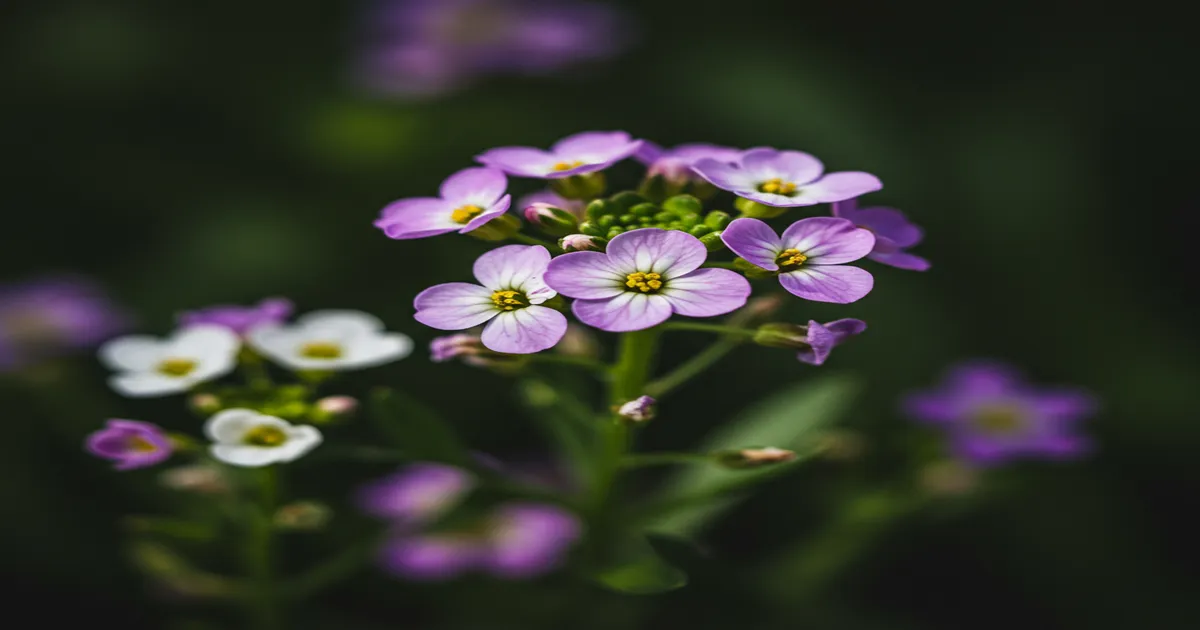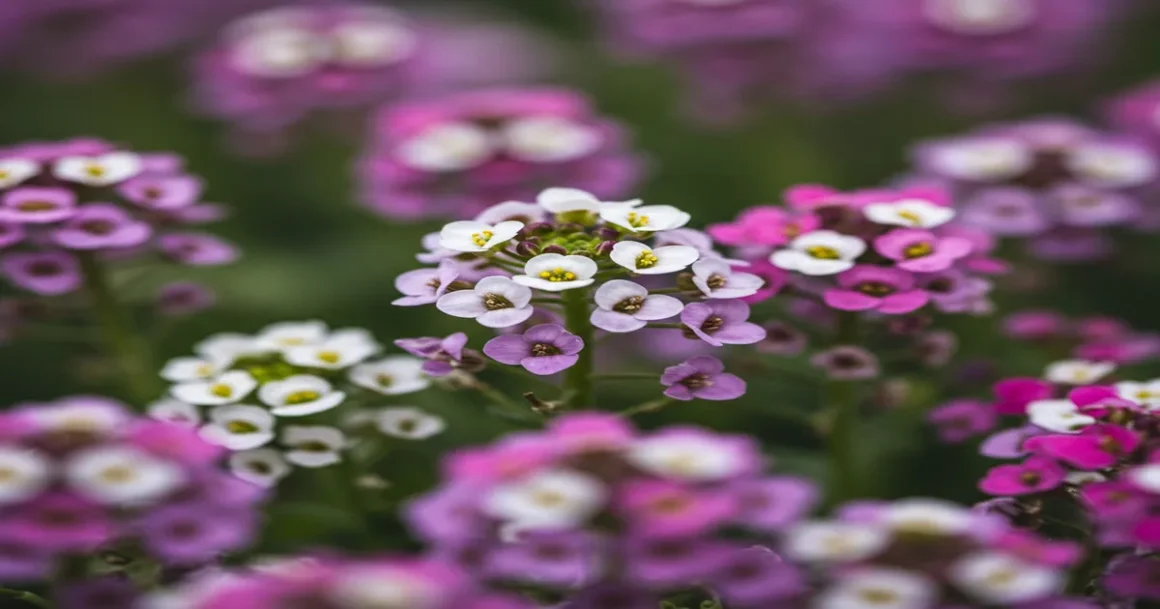Sweet alyssum produces a vibrant carpet of small flowers that can cover your garden or landscape. This plant quickly spreads with tiny four-petal, cross-shaped flowers after just two months from seed. Its narrow, lance-shaped leaves are slightly hairy and gray-green.
Simple to cultivate from seeds or plants, sweet alyssum is a cool-season flower originating from Europe. It should be planted in early spring once the threat of frost has passed (in regions without frost, it can also be grown in the fall and winter). While most varieties may wilt in the heat, they will bloom again in the autumn.
Varieties of Sweet Alyssum

There are several common types of sweet alyssum:
- ‘Easter Bonnet’: This early blooming type is usually found in lavender or white
- ‘New Carpet of Snow’: A compact variety covered in small white flowers
- ‘Pastel Carpet’: This type features blooms that combine pink, lavender, and cream colors
- ‘Snow Crystals’: A neat, mounding variety with clear white flowers
- ‘Snow Princess’: A robust variety that is heat tolerant, producing fragrant white flowers; it can grow up to six inches tall and five feet long
- ‘Royal Carpet’: With a height of just 3 inches and rich purple-violet flowers, this variety lives up to its regal name.
Trimming

Removing faded flowers from sweet alyssum will help the plants bloom continuously and develop new buds rapidly. If you have a large group of plants, cutting them back by one-third is a simpler alternative to deadheading. Certain types of plants will naturally sow new seeds. As the plants have a tendency to grow long and untidy, regular trimming will help them maintain a tidy appearance.
Instructions for Growing Sweet Alyssum From Seed

Sweet alyssum is commonly found in nursery flats, but you can also cultivate it by sowing seeds in early spring. Begin by starting the seeds indoors before the final frost or by planting them directly outdoors once the soil is workable.
Sweet alyssum typically self-seeds vigorously, but hybrid varieties may not resemble the original plant.
Instructions for Potting and Repotting Sweet Alyssum

Sweet alyssum thrives when planted in containers. When using containers, it is important to utilize high-quality potting soil and ensure that there are drainage holes at the bottom of the container to allow excess water to drain out. Sweet alyssum is commonly used in hanging baskets or window boxes, either on its own or alongside petunias and other plants with similar care requirements.
When transplanting, fill the container with soil, create a hole that matches the size of the current root ball, place the root ball in the hole, and fill the surrounding soil. Maintain a gap of at least two inches between the soil level and the top of the container.
Winterizing

To prepare alyssum for winter, you can trim it back, protect it with frost cloth, or bring potted plants indoors. Another option is to leave it as is. Since it self-seeds abundantly, in late winter or early spring, after the ground starts to thaw, clear away any dead foliage to create space for seeds from the previous growing season to fall onto the soil and sprout.
Types of Pests and Plant Diseases
Sweet alyssum usually does not face any issues, but aphids may appear if the plant is stressed.
Sweet alyssum can be affected by downy mildew, stem and crown rot, or may deteriorate due to soil that does not drain well. Avoid overwatering these plants to maintain their health.
Tips for Inducing Flowering in Sweet Alyssum
Sweet alyssum typically blooms in early spring and fall, thriving in cooler temperatures.
Peak Blooming Months
The months of June to October offer the best display of sweet alyssum blooms.
Duration of Bloom
From germination to blooming, sweet alyssum takes about two months. While some varieties may pause flowering in hot weather, they often resume in the fall.
Appearance and Scent of Sweet Alyssum Flowers
With a delightful honey-like fragrance, sweet alyssum’s small flowers come in white, pink, and purple clusters. They can self-seed, offering vibrant colors annually in mild climates.
Promoting More Blooms
To encourage new growth when blooms appear, consider using water-soluble fertilizer.
Removing Spent Flowers from Sweet Alyssum
Regular deadheading of sweet alyssum will maintain continuous flowering and prompt the development of new buds. Alternatively, trimming the plant by half in summer can also stimulate fresh growth.
Common Issues With Sweet Alyssum
Sweet Alyssum typically thrives aggressively in warmer climates with minimal care. However, growing it outside of its ideal conditions can be challenging. Factors like high temperatures, frost, excessive water, poor drainage, unsuitable soil, or insufficient light can hinder its growth.
Drooping Flowers and Leaves
If your alyssum is not planted in well-drained soil or if it’s exposed to high temperatures, it may start drooping. Alyssum is not well-suited to intense heat. While some varieties can withstand heat without wilting, most common types will shrink in hot weather. Provide extra water to the plant, but ensure the soil drains effectively.
Drooping is common in hot weather and the plant may recover in cooler temperatures. If you’re impatient, trim back the wilted plant, water it, and use a water-soluble fertilizer to promote new growth.
Curling Flowers and Leaves
If you observe curling flowers and foliage, check under the leaves and petals for tiny sap-sucking cyclamen mites. These mites are barely visible to the naked eye but resemble small oval spiders under magnification. Use neem oil or insecticidal soap to eliminate the infestation.
Yellowing Leaves
Yellowing leaves can result from various factors such as temperature spikes, transplant shock, inadequate watering, or poor soil nutrients. It’s crucial to identify the cause early to prevent widespread damage. Often, the solution involves trimming the plant and waiting for more favorable conditions for sweet alyssum to resume its growth.
FAQ
Can sweet alyssum thrive indoors?
Sweet alyssum can be grown indoors, and many gardeners opt to bring it indoors for overwintering. However, when grown indoors, the plant loses its primary appeal in the landscape, which is filling bare patches of soil.

